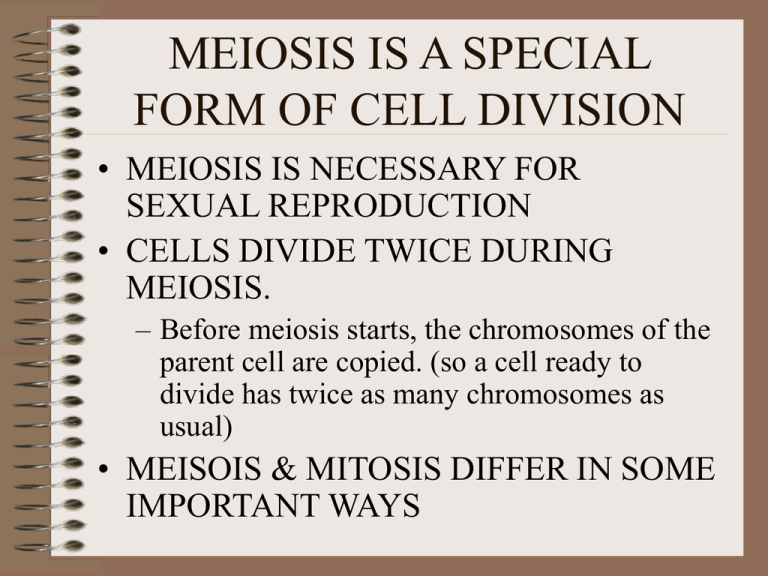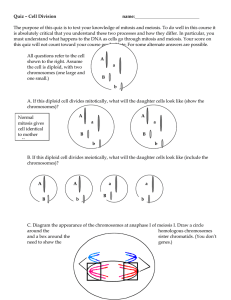MEIOSIS IS A SPECIAL FORM OF CELL DIVISION
advertisement

MEIOSIS IS A SPECIAL FORM OF CELL DIVISION • MEIOSIS IS NECESSARY FOR SEXUAL REPRODUCTION • CELLS DIVIDE TWICE DURING MEIOSIS. – Before meiosis starts, the chromosomes of the parent cell are copied. (so a cell ready to divide has twice as many chromosomes as usual) • MEISOIS & MITOSIS DIFFER IN SOME IMPORTANT WAYS SEXUAL REPRODUCTION • Human body cells have 46 chromosomes, its “diploid” number or 2n (the full number of chromosomes for the species- the 2n for a fruit fly is 8) • GAMETES: cells with ½ the usual number of chromosomes (one from each pair). Are 1n or haploid cells (sex cells). Human gametes have 23 chromosomes. • EGG is gamete formed in reproductive organ of a female; SPERM is gamete formed in male reproductive organs. FERTILIZATION: process where a sperm (1n) and an egg (1n) combine to form one new cell (2n). Sexual Reproduction • In humans the egg has 23 chromosomes, the sperm also has 23 chromosomes, and they form a fertilized egg with 46 chromosomes (the diploid number or 2n). • MEIOSIS is a special kind of cell division that makes haploid (1n) cells. During meiosis a single cell (2n) goes through 2 cell divisions: meiosis I and meiosis II. This only occurs in reproductive tissue of an organism. 2 CELL DIVISIONS • Before meiosis begins, the chromosomes of parent cell are copied (interphase); so twice as many chromosomes as normal (4n) • At the beginning of meiosis I, the cell has 2 copies of each homolog. These get separated not once, but twice during meiosis to make 4 haploid (1n) cells. • Each haploid cell has one UNPAIRED set of chromosomes • Meiosis I Prophase I: chromosomes pair up with partners; 2 sets of chromosome pairs in parent cell now (doubled homologs or 4n) • Metaphase I: each set of chromosome pairs line up along center of cell. • Anaphase I: 2 copies of one homolog are pulled apart from 2 copies of other homolog (to opposite ends of parent cell) This is most critical time. • Telophase I: a new cell membrane forms at the center of cell, dividing parent cell into 2 daughter cells (each 2n now) Meiosis II • Prophase II: in each daughter cell are 2 copies each of n chromosomes (2n) still attached to each other. • Metaphase II: chromosomes line up in center of cell. • Anaphase II: the 2 copies of each chromosome separate & pull to opposite ends of the cell. • Telophase II: new cell membrane forms in center of cell, so each cell divides into 2 (1n) daughter cells, making a total of 4 (1n) cells. • In humans (& other species) only 1 of the 4 daughter cells made by a female becomes an egg. The rest dissolve or are never formed. • Meiosis & Mitosis Differ Only cells becoming gametes go through meiosis. All other cells go through mitosis • A cell dividing by meiosis goes through 2 cell divisions, but chromosomes aren’t copied before the second division. In mitosis, chromosomes are always copied before division. • Meioisis daughter cells are haploid (1n) and only have ½ of parent cells genetic material, while mitosis daughter cells are diploid (2n) and have exactly the same genetic material as the parent cell.






